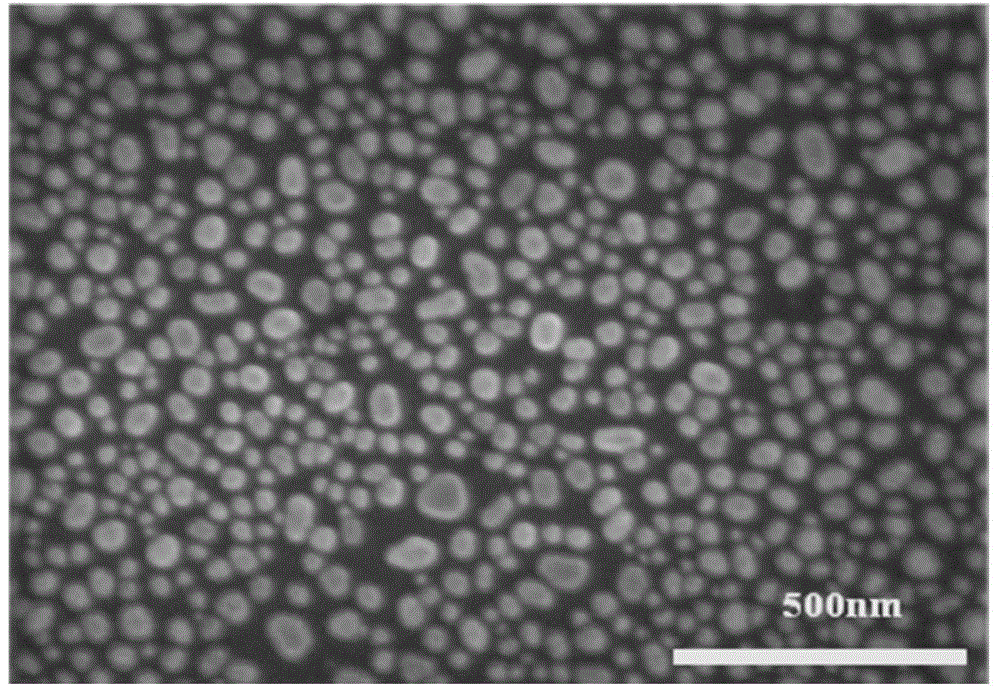A kind of solar cell based on the principle of surface plasmon enhancement and its preparation method
A surface plasmon, solar cell technology, applied in circuits, capacitors, photosensitive devices, etc., can solve problems such as poor thermal stability, and achieve the effect of increasing effective separation, rich selection, and achieving photoelectric conversion efficiency
- Summary
- Abstract
- Description
- Claims
- Application Information
AI Technical Summary
Problems solved by technology
Method used
Image
Examples
Embodiment 1
[0068] Embodiment 1. A solar cell device using single crystal zinc oxide as a wide bandgap semiconductor and K-19 dye as a photoexcitable dye; gold and silver are used as targets to vapor-deposit on graphene sheets.
[0069] The specific device preparation method is as follows:
[0070] 1. Preparation of ultra-flat zinc oxide wafers: prepare ultra-flat zinc oxide semiconductors (thickness 500nm) by magnetron sputtering, and then perform single-sided mechanical polishing on the zinc oxide wafers; Or ultrasonic cleaning in absolute ethanol for 30 minutes; then rinse with ultrapure water for 5 minutes, then rinse with deionized water for about 10 minutes, and finally blow dry with high-purity nitrogen.
[0071] 2. Evaporate low work function metals such as indium and silver on the non-mechanically polished side of the zinc oxide wafer as the back electrode; clamp the zinc oxide wafer to the top metal plate of the vacuum coating machine, so that the vacuum degree is pumped to 4.5×...
Embodiment 2
[0079] Example 2. A solar cell device using single-crystal titanium dioxide as a wide-bandgap semiconductor and N719 dye as a light-excited dye; and using gold as a target to vapor-deposit on a graphene sheet.
[0080] The specific device preparation method is as follows:
[0081] 1. Preparation of ultra-flat titanium dioxide wafers: preparation of ultra-flat titanium dioxide semiconductors (thickness of 300 nm) by magnetron sputtering, and then single-sided mechanical polishing of the titanium dioxide wafers; then etching with a 35% HF aqueous solution for 8 minutes, Then it was etched in 20W oxygen plasma for 80s.
[0082] 2. Evaporate the low work function metal of indium and silver on the unpolished side of the titanium dioxide wafer as the back electrode; clamp the titanium dioxide wafer to the top metal plate of the vacuum coating machine, so that the vacuum degree is pumped to 4.5×10 -4 Pa, which was vapor-deposited on the back surface of the titania wafer at a molar r...
Embodiment 3
[0089] Example 3. A solar cell device using single crystal titanium dioxide as a wide-bandgap semiconductor and Z907 dye as a light-excited dye; using pure silver as a target material for vapor deposition on a graphene sheet.
[0090] The specific device preparation method is as follows:
[0091] 1. Preparation of ultra-flat titanium dioxide wafers: ultra-flat titanium dioxide semiconductors (800 nm in thickness) were prepared by magnetron sputtering, and then the titanium dioxide wafers were mechanically polished on one side; then etched with 35% HF aqueous solution for 8 minutes , followed by etching in 20W oxygen plasma for 80s.
[0092] 2. Evaporate the low work function metal of indium and silver on the unpolished side of the titanium dioxide wafer as the back electrode; clamp the titanium dioxide wafer to the top metal plate of the vacuum coating machine, so that the vacuum degree is pumped to 4.5×10 -4 Pa, according to the molar ratio of indium:silver is 1:1, which is ...
PUM
| Property | Measurement | Unit |
|---|---|---|
| thickness | aaaaa | aaaaa |
| thickness | aaaaa | aaaaa |
| thickness | aaaaa | aaaaa |
Abstract
Description
Claims
Application Information
 Login to View More
Login to View More - R&D
- Intellectual Property
- Life Sciences
- Materials
- Tech Scout
- Unparalleled Data Quality
- Higher Quality Content
- 60% Fewer Hallucinations
Browse by: Latest US Patents, China's latest patents, Technical Efficacy Thesaurus, Application Domain, Technology Topic, Popular Technical Reports.
© 2025 PatSnap. All rights reserved.Legal|Privacy policy|Modern Slavery Act Transparency Statement|Sitemap|About US| Contact US: help@patsnap.com



